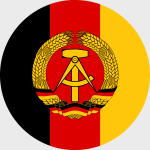Minichamps MIN350025000 East German T-72A/M-1 Main Battle Tank - Panzerregiment 16 "Leo Jogiches", 7.Panzer Division, Dresden, East Germany, 1988 (1:35 Scale)
"Were the Soviet Union to sink tomorrow under the waters of the ocean, the American military-industrial establishment would have to go on, substantially unchanged, until some other adversary could be invented. Anything else would be an unacceptable shock to the American economy."
- George Frost Kennan, American advisor, diplomat, political scientist, and historian, best known as "the father of containment" and as a key figure in the emergence of the Cold War
 The T-72, which entered production in 1971, was first seen in public in 1977. It was not intended as a further development of the T-64, but rather a parallel design chosen as a high-production tank complementing the T-64. The T-72 retains the low silhouette of the T-54/55/62 series, featuring a conventional layout with integrated fuel cells and stowage containers which give a streamlined appearance to the fenders. While the T-64 was deployed only in forward-deployed Soviet units, the T-72 was deployed within the USSR and exported to non-Soviet Warsaw Pact armies and several other countries. In addition to production in the USSR it has been built under license in Czechoslovakia, India, Poland and former Yugoslavia. The T-72A/M-1 represents the export version of the basic T-72 tank.
The T-72, which entered production in 1971, was first seen in public in 1977. It was not intended as a further development of the T-64, but rather a parallel design chosen as a high-production tank complementing the T-64. The T-72 retains the low silhouette of the T-54/55/62 series, featuring a conventional layout with integrated fuel cells and stowage containers which give a streamlined appearance to the fenders. While the T-64 was deployed only in forward-deployed Soviet units, the T-72 was deployed within the USSR and exported to non-Soviet Warsaw Pact armies and several other countries. In addition to production in the USSR it has been built under license in Czechoslovakia, India, Poland and former Yugoslavia. The T-72A/M-1 represents the export version of the basic T-72 tank.
Now Minichamps has created a gorgeous 1:35 scale diecast replica of the legendary T-72A/M-1 main battle tank. Vehicle features a rotating turret, elevating gun, working suspension, and treads that are made of flexible metal links! This particular T-72 main battle tank was attached to the East German Panzerregiment 16 "Leo Jogiches", 7.Panzer Division, then headquartered at Dresden, East Germany in 1988.
Sold Out!
Dimensions:
Length: 11-inches
Width: 4-inches
Height: 3-1/2-inches
Release Date: November 2006
Historical Account: "Serpents" - At the end of World War II, the Western allies and the USSR divided much of the world amongst themselves. Germany was no exception. The country was split into four occupation zones, which later evolved into two separate and increasingly antagonistic countries: West Germany, an ally of the West, and Communist East Germany, the right hand of the Soviet Union. Both sides evaded cease-fire agreements aimed at blocking the two Germanys from developing armed forces.
With the help of the Soviets, East Germany formed police groups of various sorts -- ground, air, water and others -- to circumvent these restrictions. By the early 1950s, these police groups had expanded to the size of small armies, each with its own administrative and mission tasks. By then the Cold War had escalated into a struggle for survival between two global power blocs, with the Soviets backing their new client state, the GDR (German Democratic Republic; in German, DDR), as it became more open in its demands for a genuine military.
In 1956, East Germany merged existing police units into recognizable armed forces: infantry, air force, navy, and other branches. In this confrontational way the East Germans began their formidable military machine -- all geared for total war against the West, including their West German blood brothers, whenever the call came from Berlin or, more accurately, from Moscow.
In 1987, the armed forces of the DDR, officially known as the National People's Army (NVA -
Nationalen Volksarmee), totaled 175,300 troops, of whom slightly over half (54%) were conscripts. The NVA comprised four main branches: ground forces, Navy, Air Force/Air Defense, and Border Guards, who technically were under the control of the Ministry of Defense, but in the field cooperated closely with the ground forces.
The actual number of male and female soldiers under arms was much larger, however, than the figure above indicates. East Germany's Communist leaders followed the Soviets in having available an assortment of auxiliary forces with military capabilities to support the regime. The list includes several types of police, militia, para-military and special mission units.
It is vital to note that these forces were subordinate to Soviet forces stationed in East Germany, which numbered 380,000 men organized into 20 infantry divisions and one air army. In addition to countering NATO, the Soviets placed so many troops in the DDR to ensure internal security and to keep the East Germans from rising up against their larger Communist brother.





 Minichamps M72 DDR MBT
Minichamps M72 DDR MBT 


